Статья о содержании и разведении карликового бадиса Dario dario.
На английском языке.
Dario dario
Dario dario comes from Assam and West Bengal in India. The locality has been described as still, crystal-clear water with a maximum depth of 5 meters (16 feet), 6 degrees GH, KH immeasurable, and a pH of 6.4. Vallisneria sp. is known to grow in the area.
It was in July 2004 when I received seven fry, about a centimeter long each, as a gift from Mr. Slavomil Boudny, a friend of mine and a well-known aquarist from Jilemnice, in the Czech Republic. Slavomil has been keeping in excellent touch with German aquarium fans for years, and he is able to get hold of virtually everything new that appears in Europe. At the time he gave me these fry they cost about 20 Euro (US $24) each in Europe. He brought them from Germany sometime in the spring of 2004, reproducing them in a limited quantity.
Keeping Notes
My fish grew up quickly on generous feedings of minuscule Daphnia and gnat and midge larvae and commenced their spawning activity within one month. A warning is in order in regard to feeding: the fish snatch anything greedily and aren't necessarily able to tell that the size of a food organism is beyond their capacity. There were several instances where I had to save such a fish by pulling a worm out of its mouth or its gullet. However, it is a very delicate intervention in a fish which does not exceed 2 1/2 centimeters (1 inch).
Spawning
The fish prefer spawning in a tangle of fine-leaf plants such as Java moss. Spawning activity takes place daily starting around 11 a.m. and lasting until about 4 p.m., with occasional breaks of several days. A little direct sunshine is a stimulus to spawning, but not a necessity. The male colors up spectacularly, his red color more intensive, with the blue edge of the dorsal fin turning a nearly shining blue. The male glides around the female, luring her into the tangle of plants. The female tries to escape at first, receiving a nudge by the male's mouth from time to time.

Above: A red spawning rash appears on the nose and the gill cover of the male Dario dario. Below: Several red spots appear on the side of the female as she becomes ripe with eggs, her urogenital papilla eventually becoming distended by the roe.
However, the longer this lasts, the more the female's belly swells, and soon the hard roe appears, visible through the abdominal wall close to the urogenital papilla.
In this phase the female gets disposed to spawn. She either lets herself be driven into the plant tangle by the male, or she follows him on her own. Sometimes she assumes a position partially on her side in the leaves, waiting to be found by the male (it doesn't take the provoked male very long to find her). Both fish struggle through the plants, side by side, until the male manages to embrace the female in a ring-like manner, turning her belly-up when one or several eggs are released and fertilized. After several seconds of convulsive embrace, the fish find themselves in a position very similar to the spawning position of Betta splendens.
Egg Care
The eggs are very fine and adhesive at the beginning, but they lose their adhesiveness later on. The pair rests for a while, and then everything starts over again. In the course of spawning, the fish do not eat their eggs, but after the spawn is finished they painstakingly seek them out and devour them. Though the male behaves territorially, protecting the spawning area against intruders, he apparently likes the taste of the eggs. Using a spawning grate is not a bad idea at all, shaking the eggs from the moss with a glass stick from time to time, causing them to fall through the grate onto the bottom, where they are protected against their parents' appetites. With the grate in place, the fish can be left in the tank for two days, virtually until the time when the small fry start hatching.
 |
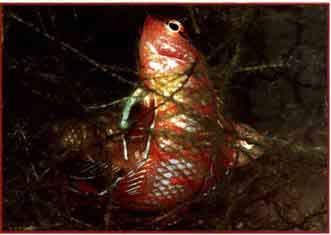 |
| Mutual courtship takes place between the male and female. |
The male and female enter side-by-side into a tangle of fine-leaved plants. |
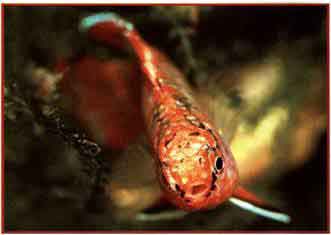 |
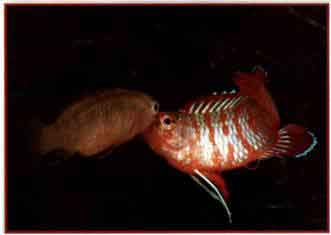 |
| The male embraces the female... |
...and one or several eggs are driven out |
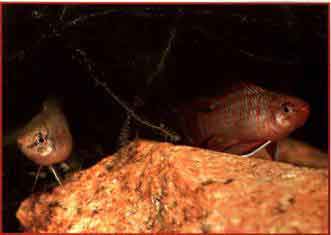 |
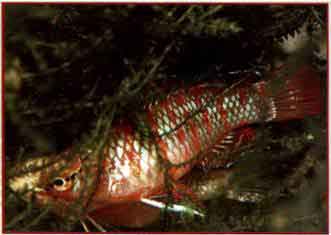 |
| The fish detach from their spawning embrace, resting for a while. |
After resting, the male resumes courtship. |
Hatching and Fry Care
Very tiny fry start hatching in about 20 to 24 hours, depending on the temperature of the water. The first day after they hatch they lay on the bottom and can be overlooked quite easily due to their size of only 3 mm. On the second day, the larvae cling to the glass of the tank, and on the third day they start to swim. They take only the tiniest living foods, not being able to swallow tiny nauplii of Artemia salina until the age of about two weeks. Until then, feeding them is not an easy job. Feeding with infusoria is difficult, and it must be carried out several times a day in small quantities.
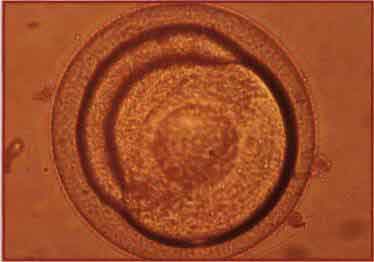
The developing egg, two hours after spawning.
Sometimes predatory infusorians become established in a Paramecium culture, resulting in the loss of fry. In such a case, if you back-light the tank, sometimes the dead body of a tiny fish with a cloud of infusoria above it is visible to the naked eye. In 15 minutes the cloud of infusoria is gone, and there is not a sign of the dead fish! Feeding with tiny rotifers or with the smallest cyclops is ideal; however, the availability of these may be limited.
Another method is to let the fish spawn in a 10-liter (3-gallon) tank with more dense Java moss. It is recommended to take the mature fish out and to pay no attention to the tank for two weeks, relying on the fry's capability of finding small food among the plants. After two weeks the fry are able to take Artemia. However, I have found that this method is not as productive, with only 10 to 20 fry from each spawning.
As soon as we change over to feeding with Artemia salina, the growth of the fry speeds up miraculously. Up until the age of four weeks, the juveniles often float with heads askew. At three months of age, sexual differentiation and commencement of spawning activity begin.
Breeding Dario dario is a bit more difficult than breeding common aquarium fish. The tiny size of the eggs and fry is the main problem. However, a tank of about 80 liters (about 20 gallons) with its back wall covered with Java moss and populated by dozens of Dario dario is a fascinating reward for a patient and careful breeder.
Due to difficulties in breeding, sensitivity of the fish, and its high price tag, however, I do not believe that mass popularity of this fish in home aquariums can be expected.
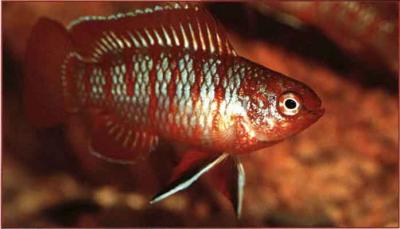
Dario dario, male.
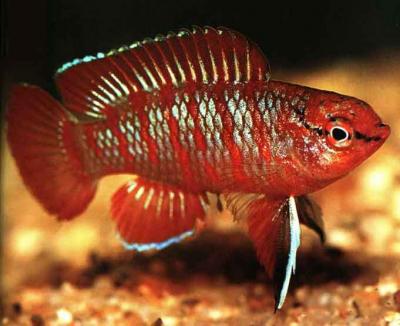
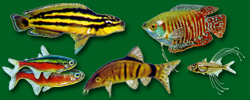













 Что-то там про медленные жернова истории...
Что-то там про медленные жернова истории...
